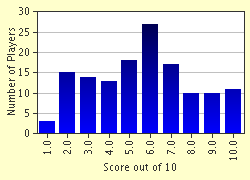Quiz Answer Key and Fun Facts
1. One of the early examples of this genre is Richard Lovelace's 1649 poem "To Lucasta, Going to the Wars." Lovelace knew of the heartbreak of going off to fight because he himself had fought in which recent war(s)?
2. On September 14, 1830, the Boston Daily Advertiser reported that the U.S.S. Constitution was to be scrapped. Two days later, a 21-year-old law student published "Old Ironsides", a poem which spearheaded the movement to restore her. Who was that law student?
3. One of the Tennyson's most famous poems deals with the "Charge of the Light Brigade" in the Crimean War. According to Tennyson, how many soldiers rode with the brigade that day?
4. One poet who was more famous for two poems written upon the death of Abraham Lincoln served as a nurse during the American Civil War and based his "The Wound Dresser" on his experiences there. Who was this poet?
5. With the advent of World War I, the romanticism of Tennyson's "Charge of the Light Brigade" was replaced by a much darker verse. Whose "Dulce Et Decorum Est" is a prime example of this gloom?
6. Another famous poem of the First World War is John McRae's 1915 "In Flanders Fields". From whose point of view is this poem told?
7. Our final World War I poem comes from Ireland, where William Butler Yeats wrote about what kind of soldier forseeing his death?
8. After 20 years of relative peace, the world broke out into war again in 1939 and, sadly, there was more cause for poetry about the death of soldiers. Who wrote a 1945 poem about "The Death of the Ball Turrett Gunner"?
9. World War II had begun on September 1, 1939 with Adolf Hitler's invasion of Poland. What British-American author wrote a poem commemorating that awful day?
10. We finish our journey in the Vietnam War, where Denise Levertov wrote a poem asking what question about the Vietnamese people?
Source: Author
kevinatilusa
This quiz was reviewed by FunTrivia editor
bullymom before going online.
Any errors found in FunTrivia content are routinely corrected through our feedback system.

